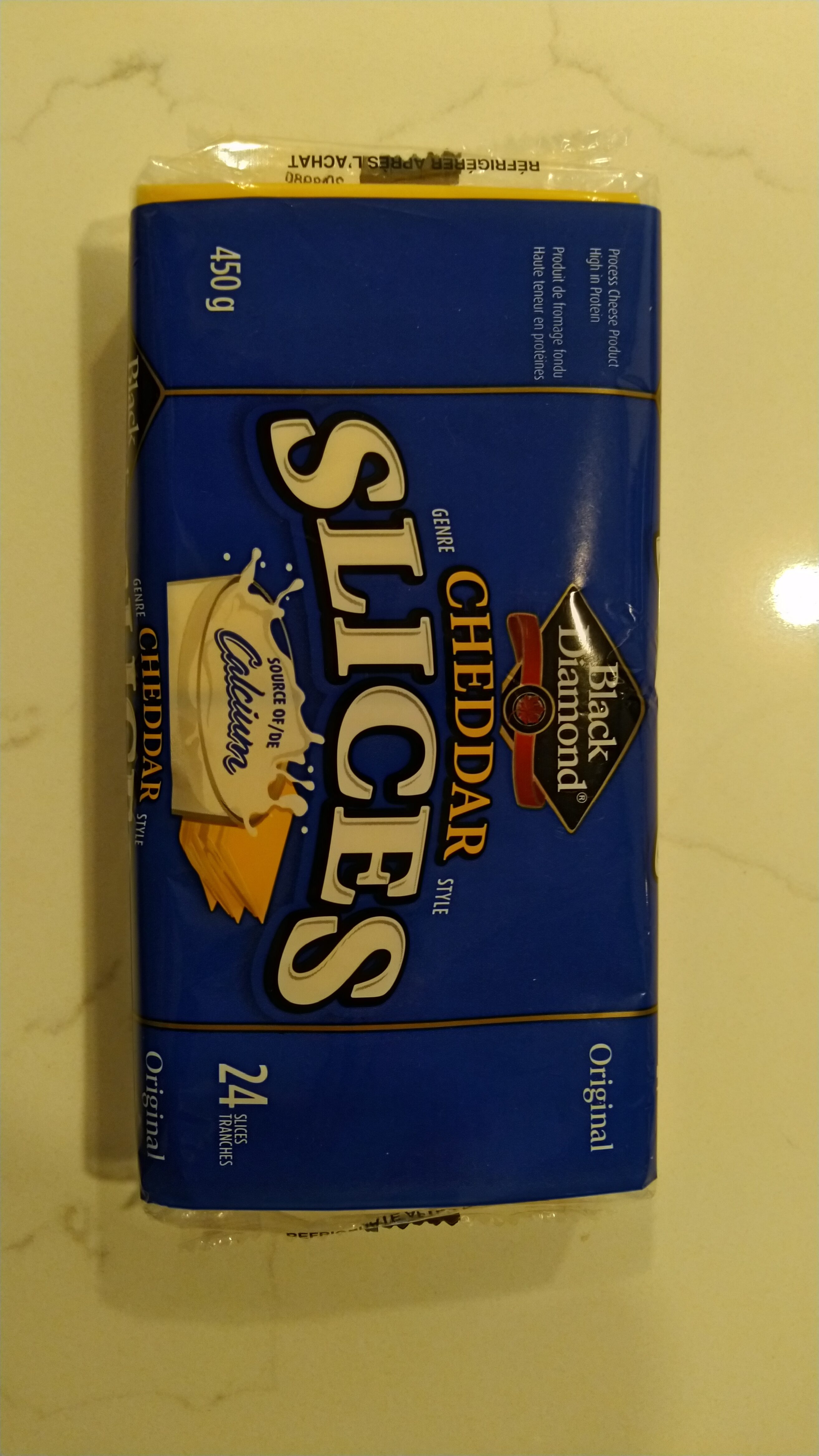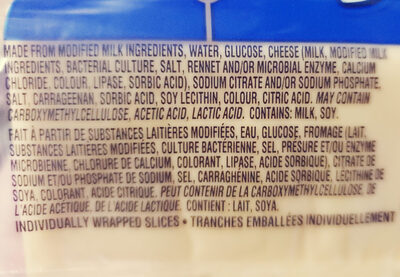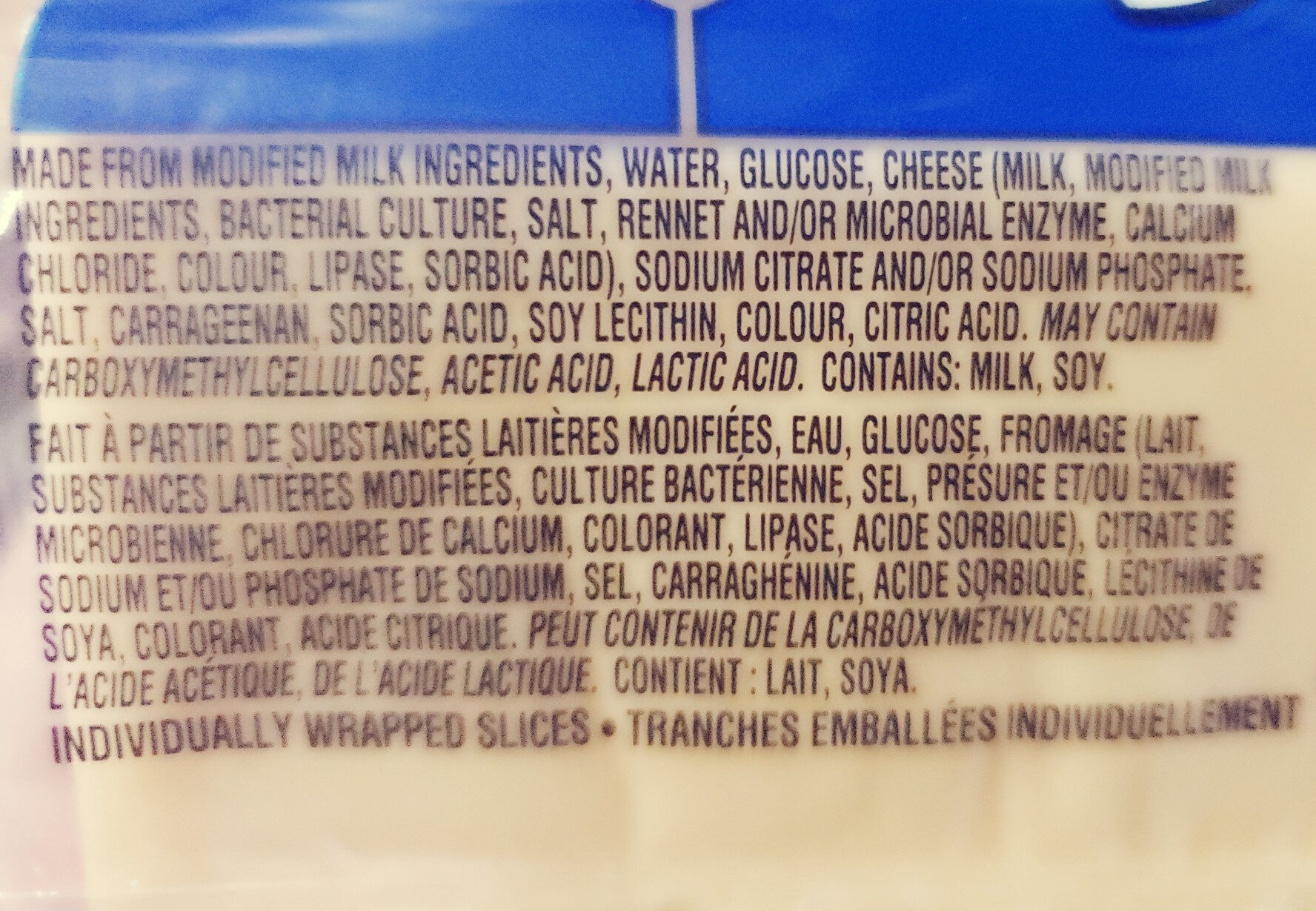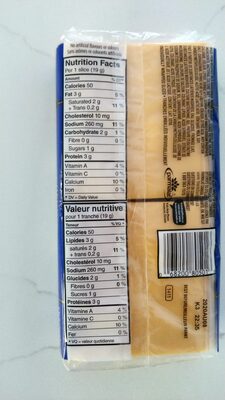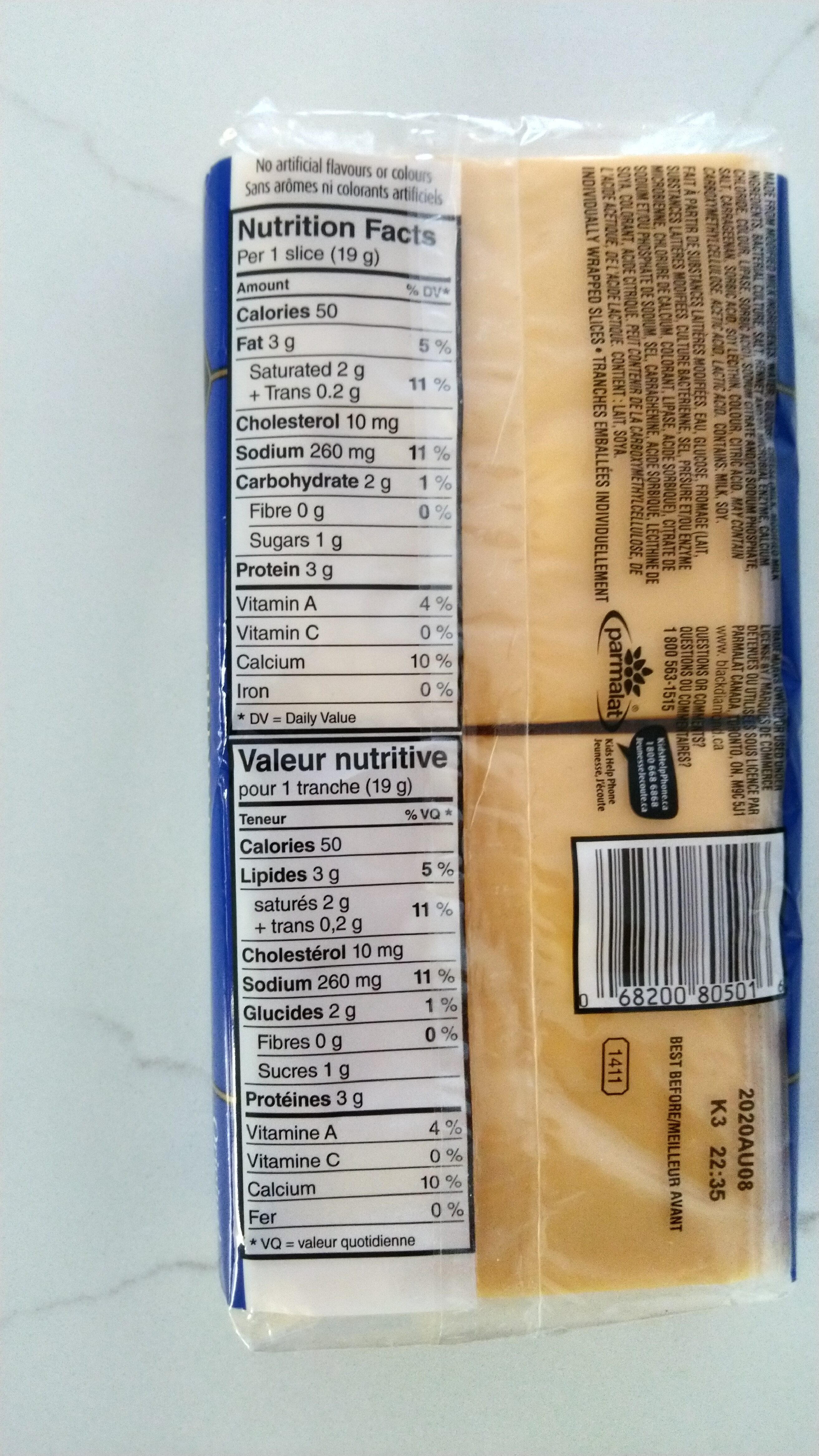Help us make food transparency the norm!
As a non-profit organization, we depend on your donations to continue informing consumers around the world about what they eat.
The food revolution starts with you!
Cheddar Slices - Black Diamond - 450
Cheddar Slices - Black Diamond - 450
This product page is not complete. You can help to complete it by editing it and adding more data from the photos we have, or by taking more photos using the app for Android or iPhone/iPad. Thank you!
×
Barcode: 0068200805016 (EAN / EAN-13) 068200805016 (UPC / UPC-A)
Quantity: 450
Brands: Black Diamond
Categories: Dairies, Fermented foods, Fermented milk products, Cheeses, Cow cheeses, Cheeses from the United Kingdom, Cheeses from England, Cheddar cheese
Labels, certifications, awards: No colorings
Countries where sold: Canada
Matching with your preferences
Health
Ingredients
-
28 ingredients
: MADE FROM MODIFIED MILK INGREDIENTS, WATER, GLUCOSE, CHEESE (MILK, MODIFIED MILK INGREDIENTS, BACTERIAL GULTURE, SALT, RENNET AND/OR MICROBIAL ENZYME, CALCIUM CHLORIDE, COLOUR, LIPASE, SORBIC ACID), SODIUM CITRATE AND/OR SODIUM PHOSPHATE, SALT, CARRAGEENAN, SORBIC ACIO, SOY LECITHIN, COLOUR, CITRIC ACID. MAY CONTAIN CARBOXYMETHYLCELLULOSE, ACETIC ACID, LACTIC ACID. CONTAINS: MILK, SOY.Allergens: Milk, Soybeans
Food processing
-
Ultra processed foods
Elements that indicate the product is in the 4 - Ultra processed food and drink products group:
- Additive: E1104 - Lipase
- Additive: E175 - Gold
- Additive: E407 - Carrageenan
- Ingredient: Glucose
Food products are classified into 4 groups according to their degree of processing:
- Unprocessed or minimally processed foods
- Processed culinary ingredients
- Processed foods
- Ultra processed foods
The determination of the group is based on the category of the product and on the ingredients it contains.
Additives
-
E1104 - Lipase
Lipase: A lipase -, - is any enzyme that catalyzes the hydrolysis of fats -lipids-. Lipases are a subclass of the esterases. Lipases perform essential roles in digestion, transport and processing of dietary lipids -e.g. triglycerides, fats, oils- in most, if not all, living organisms. Genes encoding lipases are even present in certain viruses.Most lipases act at a specific position on the glycerol backbone of a lipid substrate -A1, A2 or A3--small intestine-. For example, human pancreatic lipase -HPL-, which is the main enzyme that breaks down dietary fats in the human digestive system, converts triglyceride substrates found in ingested oils to monoglycerides and two fatty acids. Several other types of lipase activities exist in nature, such as phospholipases and sphingomyelinases; however, these are usually treated separately from "conventional" lipases. Some lipases are expressed and secreted by pathogenic organisms during an infection. In particular, Candida albicans has a large number of different lipases, possibly reflecting broad-lipolytic activity, which may contribute to the persistence and virulence of C. albicans in human tissue.Source: Wikipedia
-
E175 - Gold
Gold: Gold is a chemical element with symbol Au -from Latin: aurum- and atomic number 79, making it one of the higher atomic number elements that occur naturally. In its purest form, it is a bright, slightly reddish yellow, dense, soft, malleable, and ductile metal. Chemically, gold is a transition metal and a group 11 element. It is one of the least reactive chemical elements and is solid under standard conditions. Gold often occurs in free elemental -native- form, as nuggets or grains, in rocks, in veins, and in alluvial deposits. It occurs in a solid solution series with the native element silver -as electrum- and also naturally alloyed with copper and palladium. Less commonly, it occurs in minerals as gold compounds, often with tellurium -gold tellurides-. Gold is resistant to most acids, though it does dissolve in aqua regia, a mixture of nitric acid and hydrochloric acid, which forms a soluble tetrachloroaurate anion. Gold is insoluble in nitric acid, which dissolves silver and base metals, a property that has long been used to refine gold and to confirm the presence of gold in metallic objects, giving rise to the term acid test. Gold also dissolves in alkaline solutions of cyanide, which are used in mining and electroplating. Gold dissolves in mercury, forming amalgam alloys, but this is not a chemical reaction. A relatively rare element, gold is a precious metal that has been used for coinage, jewelry, and other arts throughout recorded history. In the past, a gold standard was often implemented as a monetary policy, but gold coins ceased to be minted as a circulating currency in the 1930s, and the world gold standard was abandoned for a fiat currency system after 1971. A total of 186‚700 tonnes of gold exists above ground, as of 2015. The world consumption of new gold produced is about 50% in jewelry, 40% in investments, and 10% in industry. Gold's high malleability, ductility, resistance to corrosion and most other chemical reactions, and conductivity of electricity have led to its continued use in corrosion resistant electrical connectors in all types of computerized devices -its chief industrial use-. Gold is also used in infrared shielding, colored-glass production, gold leafing, and tooth restoration. Certain gold salts are still used as anti-inflammatories in medicine. As of 2016, the world's largest gold producer by far was China with 450 tonnes per year.Source: Wikipedia
-
E200 - Sorbic acid
Sorbic acid: Sorbic acid, or 2‚4-hexadienoic acid, is a natural organic compound used as a food preservative. It has the chemical formula CH3-CH-4CO2H. It is a colourless solid that is slightly soluble in water and sublimes readily. It was first isolated from the unripe berries of the Sorbus aucuparia -rowan tree-, hence its name.Source: Wikipedia
-
E260 - Acetic acid
Acetic acid: Acetic acid , systematically named ethanoic acid , is a colorless liquid organic compound with the chemical formula CH3COOH -also written as CH3CO2H or C2H4O2-. When undiluted, it is sometimes called glacial acetic acid. Vinegar is no less than 4% acetic acid by volume, making acetic acid the main component of vinegar apart from water. Acetic acid has a distinctive sour taste and pungent smell. In addition to household vinegar, it is mainly produced as a precursor to polyvinyl acetate and cellulose acetate. It is classified as a weak acid since it only partially dissociates in solution, but concentrated acetic acid is corrosive and can attack the skin. Acetic acid is the second simplest carboxylic acid -after formic acid-. It consists of a methyl group attached to a carboxyl group. It is an important chemical reagent and industrial chemical, used primarily in the production of cellulose acetate for photographic film, polyvinyl acetate for wood glue, and synthetic fibres and fabrics. In households, diluted acetic acid is often used in descaling agents. In the food industry, acetic acid is controlled by the food additive code E260 as an acidity regulator and as a condiment. In biochemistry, the acetyl group, derived from acetic acid, is fundamental to all forms of life. When bound to coenzyme A, it is central to the metabolism of carbohydrates and fats. The global demand for acetic acid is about 6.5 million metric tons per year -Mt/a-, of which approximately 1.5 Mt/a is met by recycling; the remainder is manufactured from methanol. Vinegar is mostly dilute acetic acid, often produced by fermentation and subsequent oxidation of ethanol.Source: Wikipedia
-
E270 - Lactic acid
Lactic acid: Lactic acid is an organic compound with the formula CH3CH-OH-COOH. In its solid state, it is white and water-soluble. In its liquid state, it is colorless. It is produced both naturally and synthetically. With a hydroxyl group adjacent to the carboxyl group, lactic acid is classified as an alpha-hydroxy acid -AHA-. In the form of its conjugate base called lactate, it plays a role in several biochemical processes. In solution, it can ionize a proton from the carboxyl group, producing the lactate ion CH3CH-OH-CO−2. Compared to acetic acid, its pKa is 1 unit less, meaning lactic acid deprotonates ten times more easily than acetic acid does. This higher acidity is the consequence of the intramolecular hydrogen bonding between the α-hydroxyl and the carboxylate group. Lactic acid is chiral, consisting of two optical isomers. One is known as L--+--lactic acid or -S--lactic acid and the other, its mirror image, is D--−--lactic acid or -R--lactic acid. A mixture of the two in equal amounts is called DL-lactic acid, or racemic lactic acid. Lactic acid is hygroscopic. DL-lactic acid is miscible with water and with ethanol above its melting point which is around 17 or 18 °C. D-lactic acid and L-lactic acid have a higher melting point. In animals, L-lactate is constantly produced from pyruvate via the enzyme lactate dehydrogenase -LDH- in a process of fermentation during normal metabolism and exercise. It does not increase in concentration until the rate of lactate production exceeds the rate of lactate removal, which is governed by a number of factors, including monocarboxylate transporters, concentration and isoform of LDH, and oxidative capacity of tissues. The concentration of blood lactate is usually 1–2 mM at rest, but can rise to over 20 mM during intense exertion and as high as 25 mM afterward. In addition to other biological roles, L-lactic acid is the primary endogenous agonist of hydroxycarboxylic acid receptor 1 -HCA1-, which is a Gi/o-coupled G protein-coupled receptor -GPCR-.In industry, lactic acid fermentation is performed by lactic acid bacteria, which convert simple carbohydrates such as glucose, sucrose, or galactose to lactic acid. These bacteria can also grow in the mouth; the acid they produce is responsible for the tooth decay known as caries. In medicine, lactate is one of the main components of lactated Ringer's solution and Hartmann's solution. These intravenous fluids consist of sodium and potassium cations along with lactate and chloride anions in solution with distilled water, generally in concentrations isotonic with human blood. It is most commonly used for fluid resuscitation after blood loss due to trauma, surgery, or burns.Source: Wikipedia
-
E330 - Citric acid
Citric acid is a natural organic acid found in citrus fruits such as lemons, oranges, and limes.
It is widely used in the food industry as a flavor enhancer, acidulant, and preservative due to its tart and refreshing taste.
Citric acid is safe for consumption when used in moderation and is considered a generally recognized as safe (GRAS) food additive by regulatory agencies worldwide.
-
E331 - Sodium citrates
Sodium citrate: Sodium citrate may refer to any of the sodium salts of citrate -though most commonly the third-: Monosodium citrate Disodium citrate Trisodium citrateThe three forms of the salt are collectively known by the E number E331. Sodium citrates are used as acidity regulators in food and drinks, and also as emulsifiers for oils. They enable cheeses to melt without becoming greasy.Source: Wikipedia
-
E407 - Carrageenan
Carrageenan (E407), derived from red seaweed, is widely employed in the food industry as a gelling, thickening, and stabilizing agent, notably in dairy and meat products.
It can exist in various forms, each imparting distinct textural properties to food.
However, its degraded form, often referred to as poligeenan, has raised health concerns due to its potential inflammatory effects and its classification as a possible human carcinogen (Group 2B) by the International Agency for Research on Cancer (IARC).
Nevertheless, food-grade carrageenan has been deemed safe by various regulatory bodies when consumed in amounts typically found in food.
Ingredients analysis
-
Palm oil content unknown
Unrecognized ingredients: fr:made-from-modified-milk-ingredients, fr:water, fr:cheese, fr:milk, fr:modified-milk-ingredients, fr:bacterial-gulture, fr:salt, fr:rennet-and, fr:or-microbial-enzyme, fr:calcium-chloride, fr:colour, fr:sorbic-acid, fr:sodium-citrate-and, fr:or-sodium-phosphate, fr:salt, fr:carrageenan, fr:sorbic-acio, fr:soy-lecithin, fr:colour, fr:may-contain-carboxymethylcellulose, fr:lactic-acid, fr:contains, fr:milk, fr:soySome ingredients could not be recognized.
We need your help!
You can help us recognize more ingredients and better analyze the list of ingredients for this product and others:
- Edit this product page to correct spelling mistakes in the ingredients list, and/or to remove ingredients in other languages and sentences that are not related to the ingredients.
- Add new entries, synonyms or translations to our multilingual lists of ingredients, ingredient processing methods, and labels.
If you would like to help, join the #ingredients channel on our Slack discussion space and/or learn about ingredients analysis on our wiki. Thank you!
-
Vegan status unknown
Unrecognized ingredients: fr:made-from-modified-milk-ingredients, fr:water, fr:cheese, fr:milk, fr:modified-milk-ingredients, fr:bacterial-gulture, fr:salt, fr:rennet-and, fr:or-microbial-enzyme, fr:calcium-chloride, fr:colour, fr:sorbic-acid, fr:sodium-citrate-and, fr:or-sodium-phosphate, fr:salt, fr:carrageenan, fr:sorbic-acio, fr:soy-lecithin, fr:colour, fr:may-contain-carboxymethylcellulose, fr:lactic-acid, fr:contains, fr:milk, fr:soySome ingredients could not be recognized.
We need your help!
You can help us recognize more ingredients and better analyze the list of ingredients for this product and others:
- Edit this product page to correct spelling mistakes in the ingredients list, and/or to remove ingredients in other languages and sentences that are not related to the ingredients.
- Add new entries, synonyms or translations to our multilingual lists of ingredients, ingredient processing methods, and labels.
If you would like to help, join the #ingredients channel on our Slack discussion space and/or learn about ingredients analysis on our wiki. Thank you!
-
Vegetarian status unknown
Unrecognized ingredients: fr:made-from-modified-milk-ingredients, fr:water, fr:cheese, fr:milk, fr:modified-milk-ingredients, fr:bacterial-gulture, fr:salt, fr:rennet-and, fr:or-microbial-enzyme, fr:calcium-chloride, fr:colour, fr:sorbic-acid, fr:sodium-citrate-and, fr:or-sodium-phosphate, fr:salt, fr:carrageenan, fr:sorbic-acio, fr:soy-lecithin, fr:colour, fr:may-contain-carboxymethylcellulose, fr:lactic-acid, fr:contains, fr:milk, fr:soySome ingredients could not be recognized.
We need your help!
You can help us recognize more ingredients and better analyze the list of ingredients for this product and others:
- Edit this product page to correct spelling mistakes in the ingredients list, and/or to remove ingredients in other languages and sentences that are not related to the ingredients.
- Add new entries, synonyms or translations to our multilingual lists of ingredients, ingredient processing methods, and labels.
If you would like to help, join the #ingredients channel on our Slack discussion space and/or learn about ingredients analysis on our wiki. Thank you!
-
Details of the analysis of the ingredients
We need your help!
Some ingredients could not be recognized.
We need your help!
You can help us recognize more ingredients and better analyze the list of ingredients for this product and others:
- Edit this product page to correct spelling mistakes in the ingredients list, and/or to remove ingredients in other languages and sentences that are not related to the ingredients.
- Add new entries, synonyms or translations to our multilingual lists of ingredients, ingredient processing methods, and labels.
If you would like to help, join the #ingredients channel on our Slack discussion space and/or learn about ingredients analysis on our wiki. Thank you!
: MADE FROM MODIFIED MILK INGREDIENTS, WATER, GLUCOSE, CHEESE (MILK, MODIFIED MILK INGREDIENTS, BACTERIAL GULTURE, SALT, RENNET AND, OR MICROBIAL ENZYME, CALCIUM CHLORIDE, COLOUR, LIPASE, SORBIC ACID), SODIUM CITRATE AND, OR SODIUM PHOSPHATE, SALT, CARRAGEENAN, SORBIC ACIO, SOY LECITHIN, COLOUR, CITRIC ACID, MAY CONTAIN CARBOXYMETHYLCELLULOSE, ACETIC ACID, LACTIC ACID, CONTAINS (MILK), SOY- MADE FROM MODIFIED MILK INGREDIENTS -> fr:made-from-modified-milk-ingredients - percent_min: 5.88235294117647 - percent_max: 100
- WATER -> fr:water - percent_min: 0 - percent_max: 50
- GLUCOSE -> en:glucose - vegan: yes - vegetarian: yes - ciqual_proxy_food_code: 31016 - percent_min: 0 - percent_max: 33.3333333333333
- CHEESE -> fr:cheese - percent_min: 0 - percent_max: 25
- MILK -> fr:milk - percent_min: 0 - percent_max: 25
- MODIFIED MILK INGREDIENTS -> fr:modified-milk-ingredients - percent_min: 0 - percent_max: 12.5
- BACTERIAL GULTURE -> fr:bacterial-gulture - percent_min: 0 - percent_max: 8.33333333333333
- SALT -> fr:salt - percent_min: 0 - percent_max: 6.25
- RENNET AND -> fr:rennet-and - percent_min: 0 - percent_max: 5
- OR MICROBIAL ENZYME -> fr:or-microbial-enzyme - percent_min: 0 - percent_max: 4.16666666666667
- CALCIUM CHLORIDE -> fr:calcium-chloride - percent_min: 0 - percent_max: 3.57142857142857
- COLOUR -> fr:colour - percent_min: 0 - percent_max: 3.125
- LIPASE -> en:e1104 - vegan: maybe - vegetarian: maybe - percent_min: 0 - percent_max: 2.77777777777778
- SORBIC ACID -> fr:sorbic-acid - percent_min: 0 - percent_max: 2.5
- SODIUM CITRATE AND -> fr:sodium-citrate-and - percent_min: 0 - percent_max: 20
- OR SODIUM PHOSPHATE -> fr:or-sodium-phosphate - percent_min: 0 - percent_max: 16.6666666666667
- SALT -> fr:salt - percent_min: 0 - percent_max: 14.2857142857143
- CARRAGEENAN -> fr:carrageenan - percent_min: 0 - percent_max: 12.5
- SORBIC ACIO -> fr:sorbic-acio - percent_min: 0 - percent_max: 11.1111111111111
- SOY LECITHIN -> fr:soy-lecithin - percent_min: 0 - percent_max: 10
- COLOUR -> fr:colour - percent_min: 0 - percent_max: 9.09090909090909
- CITRIC ACID -> en:e330 - vegan: yes - vegetarian: yes - percent_min: 0 - percent_max: 8.33333333333333
- MAY CONTAIN CARBOXYMETHYLCELLULOSE -> fr:may-contain-carboxymethylcellulose - percent_min: 0 - percent_max: 7.69230769230769
- ACETIC ACID -> en:e260 - vegan: yes - vegetarian: yes - percent_min: 0 - percent_max: 7.14285714285714
- LACTIC ACID -> fr:lactic-acid - percent_min: 0 - percent_max: 6.66666666666667
- CONTAINS -> fr:contains - percent_min: 0 - percent_max: 6.25
- MILK -> fr:milk - percent_min: 0 - percent_max: 6.25
- SOY -> fr:soy - percent_min: 0 - percent_max: 5.88235294117647
Nutrition
-
Bad nutritional quality
⚠ ️Warning: the amount of fruits, vegetables and nuts is not specified on the label, it was estimated from the list of ingredients: 0This product is not considered a beverage for the calculation of the Nutri-Score.
Positive points: 5
- Proteins: 5 / 5 (value: 15.8, rounded value: 15.8)
- Fiber: 0 / 5 (value: 0, rounded value: 0)
- Fruits, vegetables, nuts, and colza/walnut/olive oils: 0 / 5 (value: 0, rounded value: 0)
Negative points: 24
- Energy: 3 / 10 (value: 1100, rounded value: 1100)
- Sugars: 1 / 10 (value: 5.26, rounded value: 5.26)
- Saturated fat: 10 / 10 (value: 10.5, rounded value: 10.5)
- Sodium: 10 / 10 (value: 1370, rounded value: 1370)
The points for proteins are counted because the product is in the cheeses category.
Nutritional score: (24 - 5)
Nutri-Score:
-
Nutrient levels
-
Fat in moderate quantity (15.8%)
What you need to know- A high consumption of fat, especially saturated fats, can raise cholesterol, which increases the risk of heart diseases.
Recommendation: Limit the consumption of fat and saturated fat- Choose products with lower fat and saturated fat content.
-
Saturated fat in high quantity (10.5%)
What you need to know- A high consumption of fat, especially saturated fats, can raise cholesterol, which increases the risk of heart diseases.
Recommendation: Limit the consumption of fat and saturated fat- Choose products with lower fat and saturated fat content.
-
Sugars in moderate quantity (5.26%)
What you need to know- A high consumption of sugar can cause weight gain and tooth decay. It also augments the risk of type 2 diabetes and cardio-vascular diseases.
Recommendation: Limit the consumption of sugar and sugary drinks- Sugary drinks (such as sodas, fruit beverages, and fruit juices and nectars) should be limited as much as possible (no more than 1 glass a day).
- Choose products with lower sugar content and reduce the consumption of products with added sugars.
-
Salt in high quantity (3.42%)
What you need to know- A high consumption of salt (or sodium) can cause raised blood pressure, which can increase the risk of heart disease and stroke.
- Many people who have high blood pressure do not know it, as there are often no symptoms.
- Most people consume too much salt (on average 9 to 12 grams per day), around twice the recommended maximum level of intake.
Recommendation: Limit the consumption of salt and salted food- Reduce the quantity of salt used when cooking, and don't salt again at the table.
- Limit the consumption of salty snacks and choose products with lower salt content.
-
-
Nutrition facts
Nutrition facts As sold
for 100 g / 100 mlAs sold
per serving (1 slice (19 g))Compared to: Cheddar cheese Energy 1,100 kj
(263 kcal)209 kj
(50 kcal)-30% Fat 15.8 g 3 g -46% Saturated fat 10.5 g 2 g -42% Trans fat 1.05 g 0.2 g Cholesterol 52.6 mg 10 mg -12% Carbohydrates 10.5 g 2 g +241% Fiber 0 g 0 g Sugars 5.26 g 1 g +3,383% Proteins 15.8 g 3 g -31% Salt 3.42 g 0.65 g +91% Vitamin A 316 µg 60 µg (4 % DV) Vitamin C (ascorbic acid) 0 mg 0 mg (0 % DV) Calcium 526 mg 100 mg (10 % DV) +21% Iron 0 mg 0 mg (0 % DV) -100% Fruits‚ vegetables‚ nuts and rapeseed‚ walnut and olive oils (estimate from ingredients list analysis) 0 % 0 %
Environment
-
Eco-Score C - Moderate environmental impact
⚠ ️The full impact of transportation to your country is currently unknown.The Eco-Score is an experimental score that summarizes the environmental impacts of food products.→ The Eco-Score was initially developped for France and it is being extended to other European countries. The Eco-Score formula is subject to change as it is regularly improved to make it more precise and better suited to each country.Life cycle analysis
-
Average impact of products of the same category: C (Score: 47/100)
Category: Cheddar cheese, from cow's milk
Category: Cheddar cheese, from cow's milk
- PEF environmental score: 0.59 (the lower the score, the lower the impact)
- including impact on climate change: 6.25 kg CO2 eq/kg of product
Stage Impact Agriculture
84.7 %Processing
7.0 %Packaging
3.7 %Transportation
2.8 %Distribution
1.5 %Consumption
0.4 %
Bonuses and maluses
-
Origins of ingredients with a high impact
Malus:
Environmental policy: +5
Transportation: 0
Origin of the product and/or its ingredients % of ingredients Impact United Kingdom 100 %Medium
-
Missing packaging information for this product
Malus: -15
⚠ ️ The information about the packaging of this product is not filled in.⚠ ️ For a more precise calculation of the Eco-Score, you can modify the product page and add them.
If you are the manufacturer of this product, you can send us the information with our free platform for producers.
Eco-Score for this product
-
Impact for this product: C (Score: 48/100)
Product: Cheddar Slices - Black Diamond - 450
Life cycle analysis score: 47
Sum of bonuses and maluses: -15
Final score: 48/100
-
Carbon footprint
-
Equal to driving 3.2 km in a petrol car
625 g CO² per 100g of product
The carbon emission figure comes from ADEME's Agribalyse database, for the category: Cheddar cheese, from cow's milk (Source: ADEME Agribalyse Database)
Stage Impact Agriculture
85.6 %Processing
6.1 %Packaging
4.2 %Transportation
3.4 %Distribution
0.6 %Consumption
0.1 %
Packaging
-
Missing packaging information for this product
⚠ ️ The information about the packaging of this product is not filled in.Take a photo of the recycling information Take a photo of the recycling information
Transportation
-
Origins of ingredients
Origins of ingredients with a high impact
Origin of the product and/or its ingredients % of ingredients Impact United Kingdom 100 %Medium
Report a problem
-
Incomplete or incorrect information?
Category, labels, ingredients, allergens, nutritional information, photos etc.
If the information does not match the information on the packaging, please complete or correct it. Open Food Facts is a collaborative database, and every contribution is useful for all.
Data sources
Product added on by openfoodfacts-contributors
Last edit of product page on by .
Product page also edited by omnomnotes-app, roboto-app.

